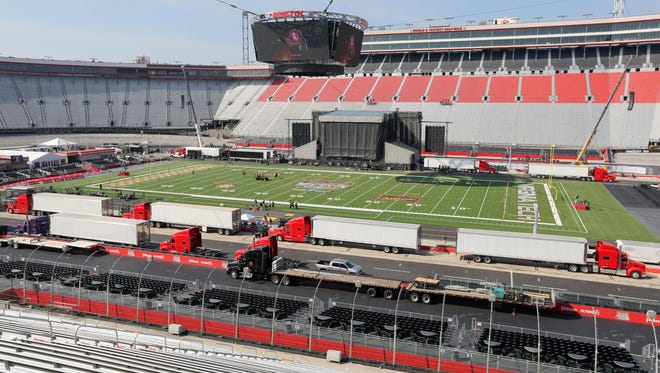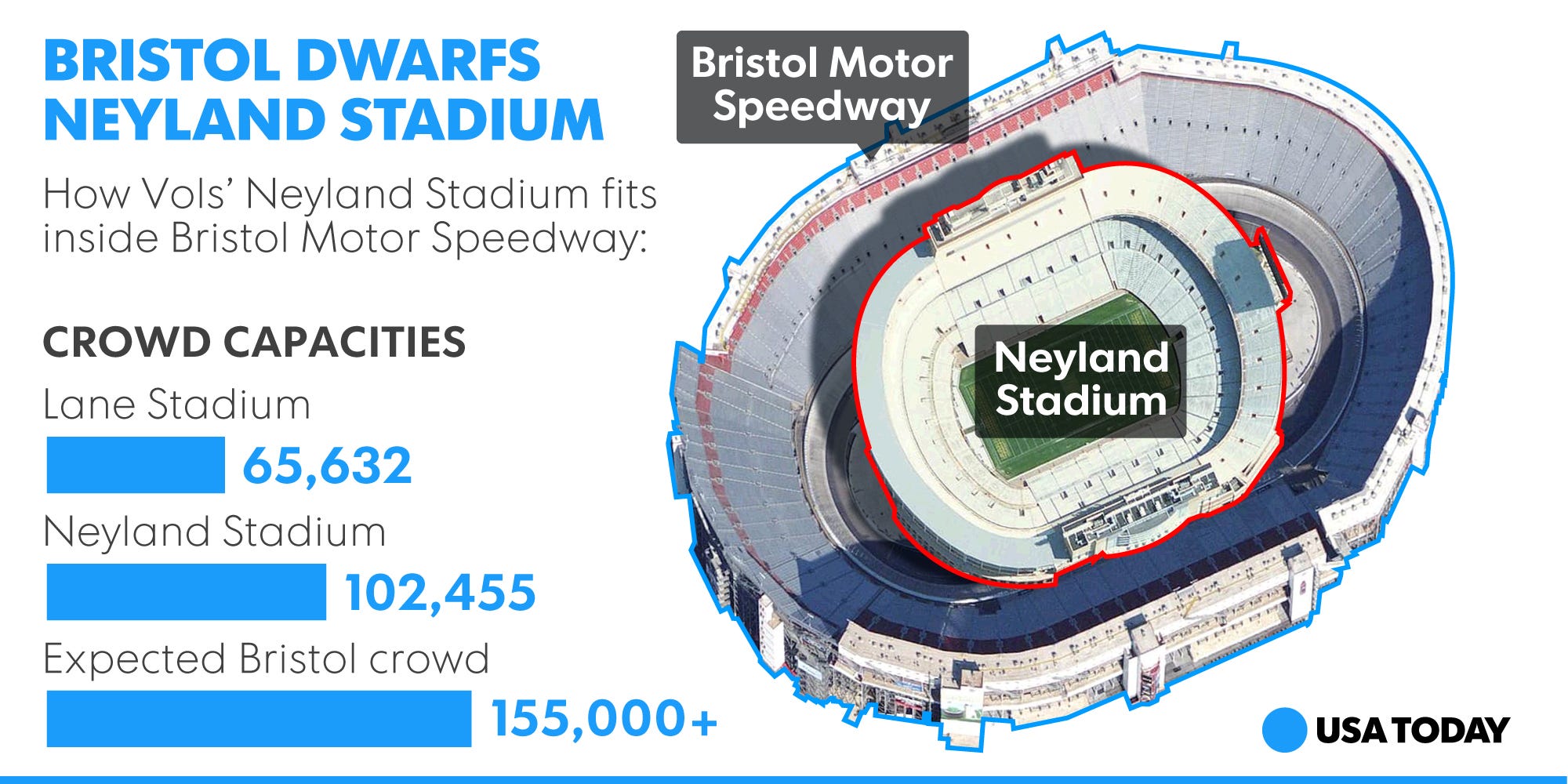College football's Bristol pit stop will be big in every way

BRISTOL, Tenn. — They have seen the photographs. They understand the concept. But no matter. This is the nearly universal first impression, the first time anyone walks out of the tunnel and into the cavernous space:
“Ginormous! Ginormous!”
That was Virginia Tech defensive end Ken Ekanem on Friday afternoon. A fifth-year senior, he has been there and done that — but no one has ever done THIS.
Bristol Motor Speedway has been called a “college football stadium on steroids,” probably by too many people to mention. But in the Hokies’ locker room (a temporarily converted tire storage facility on the infield) those words are attributed to Dale Earnhardt Jr. As a short track (only .533 mile) on the NASCAR circuit, it has an intimate feel for racing. But now, after nearly 20 years of talking, three years of planning and less than three frantic weeks of building, there’s a football field laid out on the infield.
For a day, the self-billed “Last Great Colosseum” actually is a football stadium, the largest ever. More than 150,000 people — which would be a record college football crowd by more than 30,000 — are expected to attend Saturday’s game between Tennessee and Virginia Tech, or the “Battle at Bristol.”

This mash-up of racing and football — add a Kenny Chesney concert Friday night, and really the whole thing is more like a Southern-fried overlap — figures to be a ginormous spectacle in almost every way.
“You look at the fan bases, they’re very similar,” says Marcus Smith, CEO of Speedway Motorsports, Inc. “You’ve got a lot of fantastic, rabid fans out there for both (sports). … It’s really cool to be able to pull NASCAR, college football and the love of the game all together at once.”
***
Why do this? Essentially, the answer is: Because we can.
The game was the brainchild, all those years ago, of Bruton Smith, the CEO of Speedway Motorsports, Inc., which owns Bristol Motor Speedway. With Tennessee and Virginia Tech, schools nearly equidistant from Bristol, which is actually two towns in two states — the Virginia-Tennessee border runs right down State Street downtown — they had the right schools.
“It’s a natural, having Tennessee play Virginia Tech,” says Jerry Caldwell, vice president and general manager of Bristol Motor Speedway. “The stars aligned for us to be able to pull this off.”
Mike Vollmar, Tennessee’s senior associate athletic director for football administration, had been on the job for a couple of months in spring 2013. He wasn’t sure what to think when athletic director Dave Hart asked him to drive to Bristol and check out this wacky idea. Vollmar had been to one race, at Michigan International Speedway. But he marked off the dimensions of a football field with cones in the infield. Then he called Hart.
“We’ve got to do this,” he said. “It’s gonna be incredible.”
The logistics are incredible, too, and required hundreds of planning meetings over the past three years, with input from both schools. Along with Tennessee assistant athletic director David Elliott, Vollmar has spearheaded Tennessee’s significant part of the planning for the game.
He has made the 111-mile trip from Neyland Stadium in Knoxville to the speedway countless times. Since late August, while overseeing his usual duties tending to the myriad details of the football program, he’s spent perhaps 50% of his time in Bristol, and jokes he’s now a resident.
“You’re trying to turn a race track into a football stadium,” he says. “There’s been a lot of work involved with that.”
***
Years of planning boiled down to 10 days of transformation. At 4 a.m. Aug. 22, just hours after the completion of the Bass Pro Shops NRA Night Race — which had been delayed one day by weather — a fleet of dump trucks began rolling down the ramp, around the track and onto the infield. More than 450 truckloads later, 10,600 tons of stone-based infill had raised the level as much as 3½ feet and leveled it out. AstroTurf was installed. Goalposts, too. And they finished ahead of schedule.
That’s just the field. A building used for drivers’ medical care and meetings was repurposed as Tennessee’s locker room, complete with metal lockers that will later be used by East Tennessee State. Beyond the other end zone, Virginia Tech will use that tire storage facility. Both teams will use trailers for showers and restrooms.
Danielle Bartelstein keeps Virginia Tech football running
And all of that is just scratching the surface of what it takes to transform a race track into a football stadium, and to stage a football game.
Adam Rust, Bristol Motor Speedway’s director of purchasing, who was responsible for logistics, has been occupied by those last-minute details that inevitably popped up — everything from pallets of ice on the sidelines to adding folding chairs in the locker room for halftime position meetings.
“It’s been fun to learn this business,” Rust says. “It’s been a novelty to us — but it’s beautiful. It’s a different language from racing.”
USA TODAY Sports college football staff picks for Week 2
But the universal language will be loud. It has been a hot topic among fans since it was announced.
“People will talk about the season or a game and then they say, ‘What about Bristol?’ ” says Ekanem, the Virginia Tech senior. “You get asked about it a lot.”
Both schools quickly sold their 40,000-ticket allotments, which resulted in a $4 million payday for each school. By Friday, hundreds of RVs had staked out positions in the grassy fields surrounding the racetrack. The buzz resembles what unfolds twice a year when Bristol hosts Sprint Cup races, though instead of fragmented fan bases pulling for different drivers, it’ll be a sea of orange or maroon.
“It’s a combination of a NASCAR race and all the festivities, all of the tailgating and camping that go with that, mixed with a college football game,” Caldwell says. “It’s gonna be an interesting bled of those two worlds. It’ll be fun to see.”
But the big question remains: Once the fans get inside and the game kicks off, what will they be able to say?
Though the track feels intimate for racing, the football field is a very long way from the stands. Race cars are parked in the turns on both ends. Organizers couldn’t put seats on the steeply banked oval, and they didn’t want blank space.
“So we put race cars there just to remind people this is a speedway,” Marcus Smith says.

That might be hard to forget, especially from the very top of the Wallace Tower, high above Virginia Tech’s end zone, where for $40 you get a seat that requires binoculars. Or else, you’ll watch on Colossus, the track’s 6-month-old giant video board. Suspended above the infield — or in this case, the field — it’s the equivalent of a 13,000-square foot, three-story house. And it might be the best viewing option for some fans.
But track organizers emphasize the steep pitch of the seating, saying it’s more akin to Neyland Stadium than the Rose Bowl, with its gradual slope.
“I’m anxious to see people’s response,” Caldwell says. “I think they’ll be pleasantly surprised when they see it, and the viewing angles.”
They’ll probably be awed, anyway, by the spectacle.
2016 college football TV schedule
Tennessee coach Butch Jones has been here before. Last summer he took his assistant coaches to the track to get acquainted. He’s seen the photos and been updated on the progress. But in person, with a football field, yeah, it’s different.
“This thing,” Jones says, “is unbelievable. Very surreal.”
Coaches have emphasized staying in routine, because that’s what they always do. This is anything but. It’s why when the Vols took the field for their brief “walk-through” practice on Friday afternoon, players grabbed smartphones and took selfies.
“This is crazy,” says Tennessee quarterback Josh Dobbs. “It’s a lot bigger once you get in here.”
Just wait until Saturday. It’ll be ginormous.
